
What is a Digital Dosimeter and is it Right for You?
Technological advancements have made the range of dosimeter solutions available to organizations considerably more robust. With so many options on the market, understanding the needs of your organization has never been more important.
In this article we’ll explore what a digital dosimeter is, how they could be used, and who benefits from their use. We hope that you find this article informative, and as always, we look forward to hearing your feedback!
Minimizing Ionizing Radiation Exposure
Ionizing radiation is a form of energy that acts by removing electrons from atoms and molecules of materials, such as living tissue, water, and air. There are five types of ionizing radiation: alpha radiation, beta radiation, neutron radiation, and electromagnetic radiation (i.e. x-rays and gamma radiation).
Since ionizing radiation has the ability to alter molecules within the cells of our body, too much exposure over time can cause serious health problems (like certain types of cancer).
If your organization has employees that work with or have the potential to be exposed to radiation, the monitoring of these levels of exposure is crucial. Monitoring radiation exposure minimizes the potential health risks that accompany radiation exposure and ensures that your organization is compliant with regulations.
Calculating Radiation Dose and Personal Dose Equivalent
Generally, those in contact with radioactive materials or x-ray generating devices during the regular course of their employment (or those who have the potential to be exposed to radiation), wear personal radiation detectors or radiation dosimeters. These dosimeters are specifically designed to record and indicate the dose received by the whole body and extremities.
A radiation dosimeter measures occupational dose, which is the dose received by an individual in the course of their employment when their assigned duties involve potential exposure to radiation.
Personal dose equivalent is a measure of the biological damage to living tissue as a result of exposure to radiation. Also known as the ”biological dose,” dose equivalent is calculated as the product of the absorbed dose in tissue multiplied by a quality factor, and then sometimes multiplied by other necessary modifying factors at the specific location.
What Are Digital Dosimeters Used For?
A digital dosimeter is a semi-passive dosimeter used for determining the dose equivalent for the individuals that are wearing it. These dosimeters provide real-time information about the measured dose for the individual wearing the device.

Advantages of Digital Dosimeters
The advantages of digital dosimeters over traditional passive types are that continuous monitoring can allow for faster insights into radiation exposure, as well as a perpetual live readout of the radiation dose accumulated. The ability of instant dose insights makes digital dosimeters both easy to use, and very effective.
Digital dosimeters are a very effective way to monitor your employees that receive a wide range of doses. For example, it's very effective monitoring individuals that receive very low doses as well as individuals that are prone to receiving higher doses during the course of their employment over a wide range of occupations and industries. In the case of the workers that are receiving very low doses, a digital dosimeter will help you save time and money by reducing the logistics associated with shipping the dosimeters back and forth to the processor. For those employees receiving higher doses, more frequent monitoring will help you run a better ALARA program and be proactive in controlling the dose as opposed to being reactive.
Digital dosimeters are generally used in situations where elevated levels of radiation are potentially present, or personnel are operating in a dangerous radiation zone.
Like any other whole-body dosimeter, digital dosimeters are to be worn on the outside of clothing - generally on the chest or torso - to represent the radiation dose to the whole body.
RDC's New Whole Body Dosimeter Solution
RDC's new NetDose™ Dosimeter (Type 600295-A) utilizes silicon photomultiplier (SiPM) technology for real-time dose determination with a minimal reportable dose of 1 mrem (0.01 mSv).
The NetDose™ Dosimeter is used to monitor occupational exposure to an individual working with radioactive materials emitting gamma rays and/or X-rays. This dosimeter ensures the dose received remains within the allowable dose limits and provides organizations with real-time insights and peace of mind in confirming safety in the work environment.

Energies Measured
NetDose™ Dosimeter measures photons (both gamma and x-ray radiation) with energy between 17 keV – 6.7 MeV.
Reporting Periods
NetDose™ Dosimeter offers on-demand reporting with routine weekly readings - no need for the usual routine of shipping badges back and forth. This dosimeter takes incremental dose readings every hour and stores results in memory, which is transmitted up on demand or automatically weekly. This gives organizations more autonomy and control over radiation dose report times. This also allows the Radiation Safety Officer (RSO) and end user to make adjustments to work habits and reduce occupational exposure based on this feedback.
You can easily reassign our whole body digital dosimeter to other workers, and the dosimeter can keep track of who had the exposure at what time.
Next-Generation Safety: Radiation Detection Company Announces New Digital Dosimeter
Why Should an Organization Make the Switch to Digital Dosimeters?
Cost Savings:
The elimination of shipping requirements allows an organization to save money. Organizations that have experienced a history of lost badges can avoid these fees moving forward, as well as the gaps in dose reporting that such circumstances cause.
Peace of Mind:
On-demand dose reports provide an organization with the peace of mind that their occupational radiation workers are protected and the doses received are ALARA and within the regulatory limits. This also provides relief to workers knowing they’re either in a low-risk environment or can help proactively investigate any radiation exposure concerns.
Autonomy:
The ease of assigning and reassigning badges online, and the ability to upload dose reports when it is convenient - rather than being tied to a schedule - lead to increased autonomy within an organization's radiation safety program. Should your organization experience employee turnover, the easy reassignment of badges can be a big benefit of using digital dosimeters along with the on-demand reporting.
The above three factors combine to highlight the overall convenience of using digital dosimeters.
Let RDC Help Choose the Correct Solution for Your Organization
Radiation Detection Company has 75 years of experience providing quality dosimetry service to over 40,000 companies worldwide. Looking for assistance in understanding which of our dosimetry solutions are the best fit for your organization? Please contact us, and our team will be happy to provide guidance. To learn more about NetDose™ Dosimeter, visit here.
Have a question that we didn't address in this article? Reach out to our Support team, and one of our specialists will be more than happy to help.
Contact RDC Today
Want to learn more about digital dosimetry from Radiation Detection Company? Get answers to all of your NetDose™ questions, and learn how down-to-hourly reporting can benefit your organization.
Get a quote or contact us today to get started.



